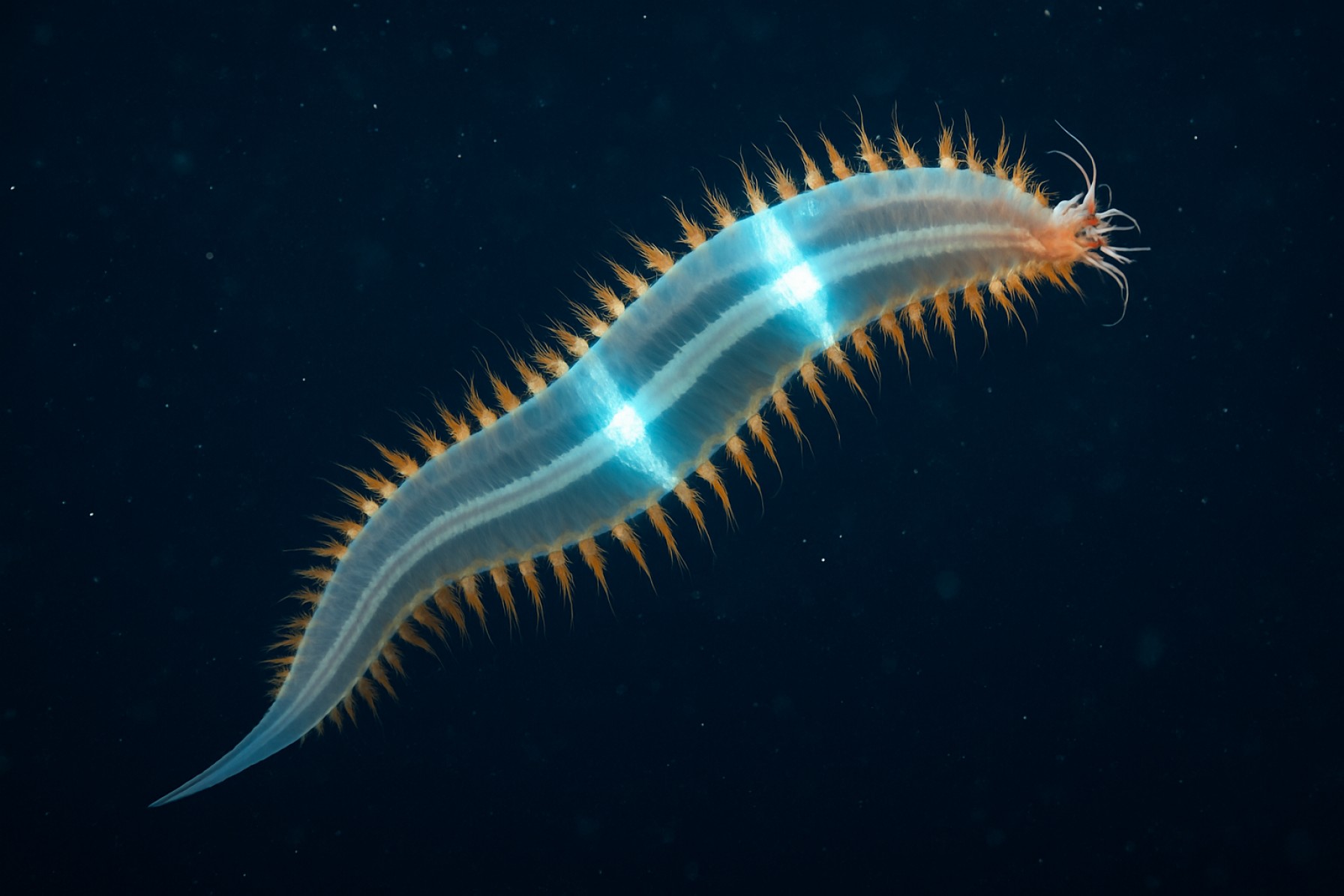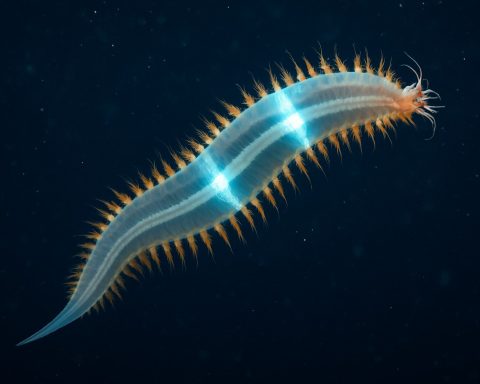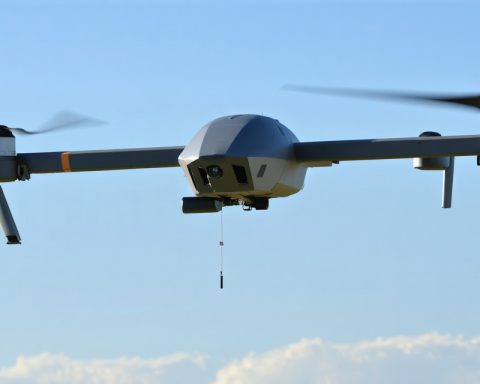Exploring Pelagic Polychaetes: The Unsung Architects of the Open Ocean. Discover How These Elusive Worms Shape Marine Ecosystems and Hold Clues to Future Ocean Health. (2025)
- Introduction: Defining Pelagic Polychaetes and Their Ecological Role
- Taxonomy and Diversity: Species Profiles and Classification
- Morphological Adaptations for Life in the Open Ocean
- Feeding Strategies and Trophic Interactions
- Reproduction, Life Cycles, and Dispersal Mechanisms
- Distribution Patterns: Global Hotspots and Environmental Drivers
- Technological Advances in Studying Pelagic Polychaetes
- Contributions to Biogeochemical Cycles and Carbon Sequestration
- Impacts of Climate Change and Ocean Acidification
- Future Outlook: Research Frontiers and Predicted Public Interest Growth (Estimated 30% Increase by 2030, per oceanographic research trends at noaa.gov)
- Sources & References
Introduction: Defining Pelagic Polychaetes and Their Ecological Role
Pelagic polychaetes are a diverse group of segmented marine worms belonging to the class Polychaeta within the phylum Annelida. Unlike their benthic relatives, which inhabit the seafloor, pelagic polychaetes are adapted to life in the open water column, often occupying various depths from the surface to the deep sea. These organisms exhibit a wide range of morphological adaptations, such as transparent or gelatinous bodies, elongated parapodia for swimming, and specialized sensory structures, enabling them to thrive in the dynamic pelagic environment.
Ecologically, pelagic polychaetes play a crucial role in marine food webs. As both predators and prey, they contribute significantly to the transfer of energy and nutrients within oceanic ecosystems. Many species feed on plankton, detritus, or smaller invertebrates, while in turn serving as an important food source for fish, cephalopods, and other larger marine animals. Their presence is particularly notable in midwater and deep-sea communities, where they can form substantial biomass and influence the vertical flux of organic matter through their feeding and migratory behaviors.
Pelagic polychaetes are also involved in biogeochemical cycles, particularly the cycling of carbon and nitrogen. Through their feeding activities and production of fecal pellets, they facilitate the downward transport of organic material, contributing to the biological pump that sequesters carbon in deeper ocean layers. This process is vital for regulating atmospheric carbon dioxide levels and maintaining the health of global marine ecosystems.
The study of pelagic polychaetes is supported by major scientific organizations and research initiatives focused on marine biodiversity and ecosystem functioning. For example, the National Oceanic and Atmospheric Administration (NOAA) conducts extensive research on pelagic ecosystems, including the distribution and ecological roles of polychaetes. Similarly, the European Marine Board coordinates collaborative research efforts across Europe to advance understanding of marine life, including pelagic annelids. These organizations emphasize the importance of pelagic polychaetes as indicators of ocean health and as integral components of marine biodiversity.
In summary, pelagic polychaetes are a vital yet often overlooked group of marine organisms. Their adaptations to the open ocean, ecological interactions, and contributions to nutrient cycling underscore their significance in sustaining the structure and function of pelagic ecosystems worldwide.
Taxonomy and Diversity: Species Profiles and Classification
Pelagic polychaetes are a diverse group of marine annelid worms that inhabit the open ocean, occupying the water column rather than the seafloor. Belonging to the class Polychaeta within the phylum Annelida, these organisms are distinguished from their benthic relatives by their adaptations for a free-swimming, planktonic lifestyle. Taxonomically, polychaetes are divided into several orders, with the majority of pelagic forms found within the orders Phyllodocida and Eunicida, though representatives also occur in other groups. The family Tomopteridae is particularly notable for its exclusively pelagic members, characterized by their transparent, laterally compressed bodies and highly developed parapodia, which facilitate efficient swimming.
Species diversity among pelagic polychaetes is substantial, with hundreds of described species and likely many more yet to be discovered, especially in deep-sea and mesopelagic zones. Notable genera include Tomopteris, Pelagobia, and Alciopina. Members of the genus Tomopteris are among the most conspicuous pelagic polychaetes, recognized for their bioluminescent capabilities and widespread distribution in temperate and tropical oceans. Alciopina species are remarkable for their large, well-developed eyes, an adaptation to the low-light conditions of the midwater environment.
The classification of pelagic polychaetes has historically relied on morphological features such as body shape, parapodial structure, chaetae (bristles), and sensory organ development. However, recent advances in molecular phylogenetics have led to significant revisions in polychaete taxonomy, revealing cryptic diversity and clarifying evolutionary relationships. These studies have shown that pelagic lifestyles have evolved multiple times independently within Polychaeta, resulting in convergent morphological adaptations among unrelated lineages.
Pelagic polychaetes play important ecological roles as both predators and prey in oceanic food webs. Their diversity reflects a wide range of feeding strategies, from active predation to suspension feeding. The ongoing discovery and classification of new species are facilitated by international research initiatives and oceanographic surveys, often coordinated by organizations such as the MarineBio Conservation Society and the Woods Hole Oceanographic Institution, both of which contribute to the cataloging and understanding of marine biodiversity.
In summary, the taxonomy and diversity of pelagic polychaetes illustrate the evolutionary complexity and ecological significance of these annelids in the open ocean. Continued research, integrating both morphological and genetic data, is essential for resolving their classification and uncovering the full extent of their species richness.
Morphological Adaptations for Life in the Open Ocean
Pelagic polychaetes, a diverse group of segmented marine worms, exhibit a remarkable suite of morphological adaptations that enable them to thrive in the open ocean’s challenging environment. Unlike their benthic relatives, pelagic polychaetes are adapted for a life spent suspended in the water column, often far from the seafloor. Their body structures reflect the demands of buoyancy, locomotion, feeding, and predator avoidance in the pelagic zone.
One of the most distinctive adaptations is body transparency. Many pelagic polychaetes possess translucent or even fully transparent tissues, which help them evade visual predators in the well-lit upper ocean. This transparency is achieved through the reduction or modification of pigments and the minimization of internal structures that could scatter light. Such adaptations are especially prevalent among members of the family Tomopteridae, whose gelatinous bodies are nearly invisible in their natural habitat.
Locomotion in the open ocean requires efficient movement through water with minimal energy expenditure. Pelagic polychaetes often have elongated, laterally compressed bodies and well-developed parapodia (paired, paddle-like appendages) that function as swimming organs. These parapodia are frequently fringed with setae (bristles), increasing surface area and providing effective propulsion. Some species, such as those in the genus Tomopteris, are capable of rapid, undulating swimming motions, allowing them to escape predators and pursue prey.
Buoyancy regulation is another critical adaptation. Many pelagic polychaetes have evolved reduced or absent chaetae (bristles) and lighter, gelatinous tissues, which decrease their overall density and help maintain neutral buoyancy. This adaptation minimizes the energy required to remain suspended in the water column. In some cases, the coelomic cavity (body cavity) is filled with fluids of lower density than seawater, further aiding buoyancy.
Feeding adaptations are also prominent. Pelagic polychaetes display a range of mouthpart modifications suited to their diets, which may include plankton, detritus, or even other zooplankton. Some possess elongated, eversible proboscises for capturing prey, while others have specialized jaws or tentacles for filter feeding. Sensory adaptations, such as well-developed eyes and chemosensory organs, are common, enabling these worms to detect food and mates in the vast, three-dimensional pelagic environment.
These morphological features collectively illustrate the evolutionary ingenuity of pelagic polychaetes, allowing them to exploit ecological niches in the open ocean. Their adaptations are the subject of ongoing research by marine biologists and organizations such as the MarineBio Conservation Society and the National Oceanic and Atmospheric Administration, which continue to expand our understanding of these fascinating organisms and their roles in marine ecosystems.
Feeding Strategies and Trophic Interactions
Pelagic polychaetes, a diverse group of segmented marine worms inhabiting the open ocean, exhibit a wide array of feeding strategies that reflect their adaptation to the dynamic pelagic environment. These organisms occupy various trophic levels, functioning as both primary and secondary consumers, and play a crucial role in marine food webs.
The feeding mechanisms of pelagic polychaetes are highly variable and often correspond to their morphological adaptations. Many species are active predators, equipped with eversible pharynges armed with jaws or teeth, enabling them to capture zooplankton, small crustaceans, and even other polychaetes. For example, members of the family Tomopteridae are known for their agile swimming and predatory behavior, preying on copepods and other small planktonic animals. In contrast, some pelagic polychaetes, such as those in the family Alciopidae, possess large, sensitive eyes and elongated bodies, allowing them to visually locate and ambush prey in the dimly lit mesopelagic zone.
Other pelagic polychaetes adopt a more opportunistic or omnivorous feeding strategy. These species may consume detritus, marine snow, or suspended organic particles, thus contributing to the recycling of organic matter in the water column. Suspension feeding is also observed in certain taxa, where specialized appendages or ciliated structures are used to capture particulate food from the surrounding water. This diversity in feeding modes enables pelagic polychaetes to exploit a range of food resources, enhancing their ecological success in nutrient-variable environments.
Trophic interactions involving pelagic polychaetes are complex and multifaceted. As both predators and prey, they form essential links between lower and higher trophic levels. They are a significant food source for a variety of pelagic fishes, cephalopods, and gelatinous zooplankton, including medusae and ctenophores. Their predation on smaller zooplankton helps regulate planktonic community structure, while their consumption by larger animals facilitates the transfer of energy up the food chain. Additionally, the vertical migrations exhibited by some pelagic polychaetes contribute to the biological pump, transporting organic material from surface waters to deeper layers, thereby influencing carbon cycling in the ocean.
Research on pelagic polychaete feeding ecology is ongoing, with advances in molecular gut content analysis and stable isotope techniques providing new insights into their dietary preferences and trophic roles. Organizations such as the Woods Hole Oceanographic Institution and the Monterey Bay Aquarium Research Institute are at the forefront of these studies, utilizing deep-sea exploration technologies to better understand the ecological significance of pelagic polychaetes in marine ecosystems.
Reproduction, Life Cycles, and Dispersal Mechanisms
Pelagic polychaetes, a diverse group of marine annelid worms, exhibit a range of reproductive strategies, life cycles, and dispersal mechanisms that are finely tuned to the challenges of the open ocean environment. Unlike their benthic relatives, pelagic polychaetes spend all or most of their lives suspended in the water column, which influences their reproductive biology and population dynamics.
Reproduction in pelagic polychaetes is predominantly sexual, with most species being dioecious—having separate male and female individuals. Gametes are typically released into the water column, where external fertilization occurs. This broadcast spawning strategy is well-suited to the pelagic environment, allowing for wide dispersal of offspring. Some species exhibit synchronized spawning events, often timed with lunar cycles or other environmental cues, to maximize the chances of successful fertilization and to overwhelm predators with sheer numbers of gametes and larvae.
The life cycles of pelagic polychaetes generally include a planktonic larval stage, which is crucial for dispersal. After fertilization, embryos develop into trochophore larvae, a free-swimming stage characterized by bands of cilia used for locomotion and feeding. In many species, the trochophore stage is followed by a more advanced nectochaete larva, which gradually develops the segmented body plan typical of polychaetes. The duration of the larval phase can vary widely, from days to several weeks, depending on the species and environmental conditions such as temperature and food availability.
Dispersal mechanisms in pelagic polychaetes are primarily passive, relying on ocean currents to transport larvae and adults across vast distances. This passive dispersal is a key factor in the wide geographic distribution observed in many pelagic polychaete species. Some species, however, exhibit limited swimming abilities that may allow them to maintain their position within favorable water masses or to undertake vertical migrations in response to environmental gradients such as light, temperature, or food availability. Vertical migration can also play a role in predator avoidance and in accessing different food resources at various depths.
The reproductive and dispersal strategies of pelagic polychaetes contribute significantly to their ecological success in the open ocean. Their ability to produce large numbers of widely dispersed offspring ensures genetic mixing and colonization of new habitats, supporting the resilience and adaptability of their populations. Ongoing research by organizations such as the MarineBio Conservation Society and the Woods Hole Oceanographic Institution continues to shed light on the complex life histories of these important marine organisms.
Distribution Patterns: Global Hotspots and Environmental Drivers
Pelagic polychaetes, a diverse group of marine annelid worms, exhibit distinct global distribution patterns shaped by a combination of environmental drivers and oceanographic features. These organisms are found throughout the world’s oceans, from surface waters to the deep pelagic zones, but their abundance and diversity are not uniform. Instead, certain regions—often referred to as “hotspots”—harbor particularly high concentrations and species richness of pelagic polychaetes.
Global hotspots for pelagic polychaetes are frequently associated with areas of high primary productivity, such as upwelling zones, continental shelf breaks, and regions influenced by major ocean currents. For example, the Eastern Boundary Upwelling Systems (EBUS) off the coasts of California, Peru, Northwest Africa, and Namibia are recognized for their elevated polychaete biomass and diversity. These regions benefit from nutrient-rich waters that support robust phytoplankton blooms, forming the base of the food web and sustaining large populations of zooplankton, including pelagic polychaetes.
Equatorial and subtropical gyres, while generally less productive, can also support unique assemblages of pelagic polychaetes adapted to oligotrophic (nutrient-poor) conditions. In contrast, polar regions, particularly the Southern Ocean, are characterized by seasonal peaks in polychaete abundance, closely linked to phytoplankton blooms during the austral summer. The Arctic Ocean, though less studied, is also known to support specialized polychaete communities, especially in areas influenced by ice melt and freshwater input.
Environmental drivers influencing the distribution of pelagic polychaetes include temperature, salinity, oxygen concentration, and food availability. Temperature is a primary determinant, with many species exhibiting clear latitudinal gradients in distribution. Oxygen minimum zones (OMZs), which occur at intermediate depths in many ocean basins, can act as both barriers and refuges, depending on the species’ tolerance to low oxygen conditions. Some polychaetes are specially adapted to thrive in these hypoxic environments, contributing to unique community structures within OMZs.
Oceanographic processes such as mesoscale eddies, fronts, and vertical mixing further modulate the spatial and temporal distribution of pelagic polychaetes by influencing nutrient dynamics and prey availability. Climate-driven changes, including ocean warming, deoxygenation, and shifts in primary productivity, are expected to alter the distribution patterns of pelagic polychaetes in the coming decades, with potential implications for marine food webs and biogeochemical cycles.
Research on pelagic polychaete distribution is supported by international initiatives such as the Intergovernmental Oceanographic Commission of UNESCO and the Food and Agriculture Organization of the United Nations, which coordinate global ocean monitoring and biodiversity assessments. These efforts are crucial for understanding the ecological roles of pelagic polychaetes and predicting their responses to ongoing environmental change.
Technological Advances in Studying Pelagic Polychaetes
The study of pelagic polychaetes—free-swimming marine worms inhabiting the open ocean—has historically been challenged by their delicate bodies, patchy distributions, and the vastness of their habitats. However, recent technological advances have significantly enhanced our ability to observe, collect, and analyze these important members of the marine ecosystem.
One of the most transformative developments has been the deployment of advanced remotely operated vehicles (ROVs) and autonomous underwater vehicles (AUVs). These platforms, equipped with high-resolution cameras and gentle sampling devices, allow researchers to observe pelagic polychaetes in situ, minimizing damage and behavioral disturbance. The Monterey Bay Aquarium Research Institute (MBARI), a leader in deep-sea technology, has pioneered the use of ROVs for midwater biological surveys, enabling the documentation of polychaete diversity, behavior, and interactions in their natural environment.
Improvements in imaging technology have also played a crucial role. High-definition video and still photography, combined with low-light sensors, facilitate the detection and identification of even transparent or bioluminescent polychaete species. These visual records are invaluable for taxonomic studies and for understanding ecological roles. Additionally, the integration of environmental DNA (eDNA) sampling has revolutionized biodiversity assessments. By analyzing genetic material suspended in seawater, scientists can detect the presence of polychaete species without direct collection, increasing survey efficiency and reducing habitat disturbance. Organizations such as the National Oceanic and Atmospheric Administration (NOAA) have incorporated eDNA methods into their ocean monitoring programs, broadening the scope of pelagic biodiversity research.
Another significant advance is the use of molecular and genomic tools. Next-generation sequencing technologies enable detailed genetic analyses, revealing cryptic species diversity and population structures that are not apparent from morphology alone. These approaches are supported by global initiatives like the European Molecular Biology Laboratory (EMBL), which provides infrastructure and expertise for large-scale genomic studies of marine organisms.
Finally, data integration platforms and open-access databases have facilitated the sharing and synthesis of polychaete data worldwide. Collaborative efforts, such as those coordinated by the International Ocean Biogeographic Information System (IOBIS), aggregate occurrence records, genetic data, and imagery, supporting large-scale analyses of distribution patterns and responses to environmental change.
Together, these technological advances are transforming our understanding of pelagic polychaetes, enabling more comprehensive and less invasive research, and providing critical insights into the functioning of oceanic ecosystems.
Contributions to Biogeochemical Cycles and Carbon Sequestration
Pelagic polychaetes, a diverse group of marine annelid worms inhabiting the open ocean, play a significant yet often underappreciated role in global biogeochemical cycles and carbon sequestration. These organisms are distributed throughout the world’s oceans, from surface waters to the deep pelagic zones, and their ecological functions are integral to the cycling of nutrients and organic matter.
One of the primary contributions of pelagic polychaetes to biogeochemical cycles is their involvement in the oceanic biological carbon pump. As active swimmers and feeders, they consume phytoplankton, zooplankton, and detrital particles, incorporating organic carbon into their biomass. Through their metabolic processes, polychaetes produce fecal pellets and other organic detritus, which are often denser than the surrounding seawater and sink rapidly to deeper layers. This vertical transport of organic material facilitates the removal of carbon from the surface ocean, effectively sequestering it in the deep sea for extended periods. Such processes are crucial for regulating atmospheric carbon dioxide levels and mitigating climate change impacts.
Additionally, pelagic polychaetes contribute to nutrient regeneration and redistribution. Their feeding and excretion activities release dissolved inorganic nutrients such as nitrogen and phosphorus back into the water column, making these elements available for primary producers like phytoplankton. This nutrient recycling supports ocean productivity and sustains food webs across various trophic levels. The diel vertical migration exhibited by some polychaete species further enhances nutrient transport between surface and deeper waters, amplifying their influence on oceanic nutrient dynamics.
Recent research has highlighted the importance of gelatinous and soft-bodied zooplankton, including pelagic polychaetes, in the global carbon cycle. Their rapid sinking rates and high turnover contribute disproportionately to the export of organic carbon compared to their abundance. This has led to increased recognition of their role in oceanic carbon sequestration, prompting calls for their inclusion in biogeochemical models and climate projections. Organizations such as the Woods Hole Oceanographic Institution and the National Oceanic and Atmospheric Administration (NOAA) are actively involved in research and monitoring efforts to better understand these processes.
In summary, pelagic polychaetes are vital mediators of carbon and nutrient fluxes in the ocean. Their contributions to the biological carbon pump and nutrient cycling underscore their ecological significance and the need for continued research to fully integrate their roles into global biogeochemical frameworks.
Impacts of Climate Change and Ocean Acidification
Pelagic polychaetes, a diverse group of free-swimming marine worms, play a crucial role in oceanic food webs and biogeochemical cycles. As climate change and ocean acidification intensify, these organisms face significant environmental pressures that may alter their distribution, physiology, and ecological functions.
Rising ocean temperatures, a direct consequence of global climate change, can affect the metabolic rates, reproductive cycles, and geographic ranges of pelagic polychaetes. Warmer waters may accelerate their metabolism, potentially increasing their food requirements and altering their growth rates. However, elevated temperatures can also push some species beyond their thermal tolerance limits, leading to shifts in community composition and possible local extinctions. Such changes can disrupt predator-prey relationships, as polychaetes are both important prey for higher trophic levels and active predators or detritivores themselves.
Ocean acidification, driven by increased atmospheric CO2 absorption, poses additional challenges. Although polychaetes generally lack calcareous shells, acidification can still impact them indirectly. Lower pH levels can affect the availability and quality of their food sources, such as plankton, and may influence their sensory and behavioral responses. Some studies suggest that acidified conditions can impair larval development and reduce survival rates, potentially leading to population declines. Furthermore, acidification can alter the chemical cues used by polychaetes for navigation, predator avoidance, and reproduction, thereby affecting their life cycles and ecological interactions.
The combined effects of warming and acidification may also influence the vertical distribution of pelagic polychaetes. Changes in ocean stratification and oxygen minimum zones, both linked to climate change, can force these organisms to inhabit different depths, impacting their role in vertical carbon transport and nutrient cycling. As key contributors to the biological pump, polychaetes facilitate the transfer of organic matter from surface waters to the deep ocean. Disruptions in their populations or behaviors could therefore have cascading effects on carbon sequestration and overall ocean health.
Ongoing research by organizations such as the National Oceanic and Atmospheric Administration and the United Nations Educational, Scientific and Cultural Organization underscores the importance of monitoring pelagic polychaete populations as indicators of oceanic change. Understanding their responses to climate-driven stressors is essential for predicting broader ecosystem impacts and informing conservation strategies in a rapidly changing marine environment.
Future Outlook: Research Frontiers and Predicted Public Interest Growth (Estimated 30% Increase by 2030, per oceanographic research trends at noaa.gov)
The future outlook for research on pelagic polychaetes is marked by significant advancements in both scientific understanding and public interest. As oceanographic research continues to expand, projections indicate an estimated 30% increase in public engagement and scholarly focus on pelagic polychaetes by 2030, a trend supported by ongoing analyses and strategic priorities at NOAA. This surge is driven by several converging factors, including technological innovation, climate change concerns, and the growing recognition of the ecological roles these organisms play in marine ecosystems.
Emerging research frontiers are increasingly leveraging advanced molecular techniques, such as environmental DNA (eDNA) sampling and high-throughput sequencing, to uncover the diversity and distribution patterns of pelagic polychaetes. These methods are enabling scientists to detect cryptic species and monitor population dynamics with unprecedented resolution, even in remote or deep-sea environments. The integration of autonomous underwater vehicles (AUVs) and remotely operated vehicles (ROVs) is further enhancing the ability to observe polychaete behavior and interactions in situ, providing valuable insights into their life cycles and ecological functions.
Climate change is another major driver shaping the research agenda. Pelagic polychaetes are sensitive indicators of ocean health, responding rapidly to changes in temperature, oxygen levels, and food availability. As global ocean conditions shift, understanding how polychaete communities adapt or decline is critical for predicting broader impacts on marine food webs and biogeochemical cycles. This has led to increased collaboration between oceanographers, ecologists, and climate scientists, with organizations such as the UNESCO Intergovernmental Oceanographic Commission playing a coordinating role in international research efforts.
Public interest in pelagic polychaetes is also expected to grow, fueled by educational outreach and citizen science initiatives. Programs supported by institutions like Smithsonian Institution and MarineBio Conservation Society are making information about these organisms more accessible, highlighting their importance in oceanic ecosystems and their potential as indicators of environmental change. As awareness increases, so too does support for conservation measures and funding for further research.
In summary, the next decade promises substantial growth in both the scientific exploration and public appreciation of pelagic polychaetes. With continued investment in research infrastructure and cross-disciplinary collaboration, the field is poised to make significant contributions to our understanding of ocean biodiversity and resilience in the face of global change.
Sources & References
- European Marine Board
- MarineBio Conservation Society
- Monterey Bay Aquarium Research Institute
- Intergovernmental Oceanographic Commission of UNESCO
- Food and Agriculture Organization of the United Nations
- European Molecular Biology Laboratory
- United Nations Educational, Scientific and Cultural Organization







